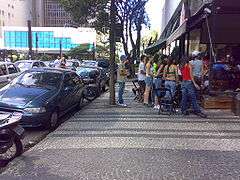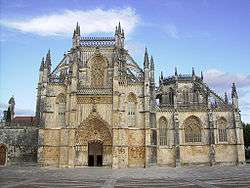Portuguese pavement

Portuguese pavement (calçada portuguesa, European Portuguese: [kɐɫˈsaðɐ puɾtuˈɣezɐ], Brazilian Portuguese: [kawˈsadɐ poʁtuˈɡezɐ]), is a traditional-style pavement used for many pedestrian areas in Portugal. It consists of small flat pieces of various different stones, arranged to form a pattern or picture, like a mosaic. It can also be found in Olivença (a disputed territory administered by Spain) and throughout old Portuguese colonies, such as Brazil and Macau. Portuguese workers are also hired for their skill in creating these pavements in places such as Gibraltar. Being usually used in sidewalks, it is in squares and atriums that this art finds its deepest expression.
One of the most distinctive uses of this paving technique is the image of Saint Elizabeth of Portugal, in Coimbra, designed with black and white stones of basalt and limestone.
Origins
Paving as a craft is believed to have originated in Mesopotamia, where rocky materials were used in the inside and outside of constructions, being later brought to Ancient Greece and Ancient Rome.
The Romans used to pave the vias connecting the empire using materials to be found in the surroundings. Some of the techniques introduced then are still applied on the calçada, most noticeably the use of a foundation and a surfacing.
An uncertain future

Very few workers (calceteiros) will admit to enjoying this arduous labour, with long hours spent painstakingly laying the stones. Low wages fail to attract apprentices.
Paved sidewalks also present hazards to pedestrians. These pavements can be particularly treacherous when they are wet, presenting a glassy, low grip surface that can contribute to slips and falls. Moreover, the stones are prone becoming loose, presenting a hazard.
This method of paving has a high cost and reduced longevity in comparison with concrete-based or bituminous alternatives.
Once an activity performed by hundreds of craftsmen in Portuguese cities and villages, traditional paving is increasingly becoming restricted to conservation works or important architectural projects. Less abundant materials, dwindling numbers of craftsmen and criticism to its widespread use are forcing municipalities to consider other alternatives.
While São Paulo is currently reforming the sidewalks of its Paulista Avenue, one of the places in the city that has Portuguese pavement, and exchanging it for a more cheap and common type of pavement, in other Brazilians cities such as Rio de Janeiro it remains popular, nearly ubiquitous in the wealthier areas.
Setting the stones
Upon a well compacted trench of argillaceous materials, craftsmen lay a bedding of gravel, which will accommodate the tessera stones, acting as a cement.
| Stages of paving | ||||||||
|---|---|---|---|---|---|---|---|---|
|
Calçada as a form of art
 Stars in Lisbon
Stars in Lisbon- Portuguese pavement in Copacabana Beach, Rio de Janeiro
- Póvoa de Varzim's runes in Praça do Almada


 A sidewalk next to Paulista Avenue, a whole neighbourhood that used to have its sidewalks entirely paved by Portuguese pavement, in São Paulo, Brazil
A sidewalk next to Paulista Avenue, a whole neighbourhood that used to have its sidewalks entirely paved by Portuguese pavement, in São Paulo, Brazil



 Transistor symbol drawn in University of Aveiro
Transistor symbol drawn in University of Aveiro Plaza de España, Olivença
Plaza de España, Olivença Pavement on the Rossio Square (Praça do Rossio), Lisbon
Pavement on the Rossio Square (Praça do Rossio), Lisbon Pavement in Ocean Village Gibraltar
Pavement in Ocean Village Gibraltar
See also
- Mosaic
- Terrazzo
- Engineered stone
- International Association of Marble, Slate and Stone Polishers, Rubbers and Sawyers, Tile and Marble Setters' Helpers and Marble Mosaic and Terrazzo Workers' Helpers
External links
| Wikimedia Commons has media related to Portuguese pavement. |
- Paving in Portuguese, urbanphoto.net
- Portuguese pavement and its histories (Portuguese language)
- The Portuguese Pavements Handbook (10 MB), Direccção Nacional de Energia e Geologia (Portuguese/English)




